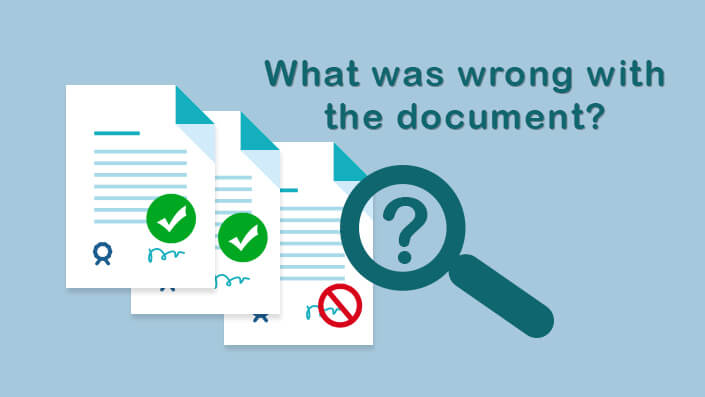
What do you mean the document got “pulled”?
Every once in a while the unthinkable happens and the document that is sent to the California County Recorder’s office for recording is rejected, or “pulled”. This is a dreaded circumstance because it means that the closing can’t happen, the Buyer can’t move in and the Seller won’t get their net proceeds until the problem is corrected. When the Escrow Officer hears the word “pulled” in conjunction with a closing, the reaction is never a good one. Our heart skips a few beats, we break out in cold sweat and our minds blank out. Yep, it’s like having a heart attack.
Let’s go back and review the role of the Escrow Holder: We are the neutral third party; we are the depository of funds and documents until certain mutually agreed upon conditions have been met. So, documents. The Escrow Holder not only holds but also prepares certain documents. Not only do the documents have to be prepared correctly, it is also our responsibility to make sure it is signed correctly, notarized correctly, all the i’s dotted, the t’s crossed (literally), before it leaves our office and goes to the County Recorder office to be recorded into the public records. If the Recorder finds problems then the documents get rejected and it gets “pulled”, meaning it gets pulled from the stack of documents waiting for recording and sent back. Ouch.
Unfortunately, we are all human, working long hours under pressure, and some things can be missed.
Here is a very general outline of the escrow process delineating the second-to-the-last-step of a closing – how the documents are processed for recording. The last step of the closing is, of course, the balancing of the file and disbursement of the funds. But before we get there….
- The Escrow Officer reviews the documents, making sure that everything is correct, the signatures are all there, the notaries are done, the legal description is attached and the sequence for recording are set out. The documents are sent to the Title Company hopefully within one day before the scheduled closing day.
- Once received the Title Officer also reviews the documents to catch anything that might have been missed. The documents are listed and stacked, in proper sequential order, and sent by to the recording service company by early evening. The recording service company is the liaison between the title company and the Recorders.
- The documents are handed to the Examiners at the Recorder’s office who examine each document late into the night and preps it for recording at 8:00 a.m. the next morning. This is when documents with inconsistencies that are not caught before are pulled.
- Early the next morning the recording service staff stand in line with their assigned title company stack of recording documents. By 8:00 and through the day, the documents are assigned a sequential Instrument number and gets date and time stamped as of “8:00 a.m.”, even if the time of day when it is stamped is later. Copies of the document with the numbering on it are made and filed in various databases. When we are alerted that our documents are stamped this means that we have received “confirmation” of recording upon which everyone gives a big sigh of relief.
(Please note that the above is a very general description of the process. There is much more to it but might confuse the readership.)
“8:00 a.m. recordings” for closings are standard in the industry. Some counties will allow “Special” recordings, which means documents brought in for file closings after 8:00 a.m. and throughout the day are accepted and gets stamped the time they are brought in. Other counties, like Los Angeles County, have a huge volume of recordings and work on “8:00 a.m. recordings” through the day, not allowing “Special” recordings unless the public walks it in themselves. For instance, on a Friday which is the last day of the month and the quarter and perhaps right before a long weekend, the “8:00 a.m. recordings” go deep into the afternoon and confirmation may not be given until 4 or 5:00 p.m.
As a measure of how many documents can be recorded at various County Recorder offices, San Diego estimates that around 2,100 documents get recorded daily. In Los Angeles County, the count is almost 4 times more, approximately 7,850 per day. Can you imagine?
With the adaptation of new technology by the County Recorder’s offices, documents can also be recorded electronically now. Electronic recordings are much easier as the physical document is scanned electronically by the recording service company to the Recorder’s office for the examiners to review, and once approved, the Recorder will issue a sequential Instrument number which will be attached to the original document. The need for standing in line waiting for the manual stamp may soon be totally replaced.
So, now that you have the background, back to the question: What do you mean the document got “pulled”? Or better yet, “What was wrong with the document that the County rejected it?” Here are some of the most common reasons for rejection:
The Notary form is the wrong format
California’s notary forms were changed by statute several years ago. Some of the old deeds and some of the mortgage documents used by a non-California Lender may have the wrong notary form attached. Escrow Officers and notaries are cautioned to review and use the correct form. It does not matter if the notarization is done out of state; in order for the document to record in California, the correct California notary forms must be used.
In addition, there are two types of forms, an Acknowledgement form and a Jurat form. Escrow Officers need to know which form to use for that particular document and attach it for the Notary Public to use.
The Notary seal is illegible
The California notary law requires that the notary seal impressed on the document be clear, crisp, sharp and readable. The seal cannot be larger than a certain size, and in this small space it has to contain the imprint of the State seal, name of the notary, county, the expiration date of the commission, the commission number and the seal manufacturer’s name ID number. Lots of information on a 1“ by 2 ½” rectangle seal . No blurry edges and no covering of pre-printed wording. It has to be legible for microfilm reproduction. Round embossed seals, although allowed, is not recommended because it does not copy, scan or microfilm well, and when not enough pressure is used, the embossment is hard to read.
The Notary form is incomplete
There are various required information to be entered on a standard notary acknowledgment or jurat form: Name of state, name of county where the notarization took place, the date, the name of the notary and title of “Notary Public”, and all the names of the signers. Anything that is missing means it is incomplete. This includes the actual signature of the Notary Public! Yes, that is a common issue.
Printed names do not match
The names of the principals showing in the document should match the names typed everywhere else on the documents, including the signature block and the notary section. It should also be signed that way, if the signature is clearly readable. For instance, if the name of the principal in the document is James John Smith, showing it or signing it as “James Smith” or “John Smith” elsewhere, is cause for rejection.
Illegible print
If the actual document is illegible, meaning the wording is too light, blurry, or has a different or dark colored background, the document will not copy well into the annals of public record. Future generations will not get a clear, readable copy and this can be seen in many early 1900s documents. The illegible document will be returned and if a clear copy or better copy is attached to the original signature copy, the Recorders will take it.
The Documentary Transfer Tax amount is missing
The recording of a Grant Deed or a Quitclaim Deed, which are documents that transfers ownership, requires the payment of a “Documentary Transfer Tax” (see my article on this subject ) If there is no payment of transfer tax notated on the document and there is no typed reason for exemption, then the document is rejected. The Recorder will not record the document without the payment of the transfer tax unless it has a valid exemption. This leads us to the next rejection.
The Documentary Transfer Tax Exemption was not accepted
As per my article regarding transfer tax exemptions there are only so many types ofexemptions that the County Tax Assessors will allow. The exemption has to be typed on the document but if it does not match to the ownership change, the Recorder will question it.
For instance, if the document wants to transfer from “John Smith, a Single man” to “James Smith, a Married Man” and the exemption used is: “This conveyance confirms a change of name, and the grantor and grantee are the same party ” this will be obvious cause for rejection.
Reference to a prior recording is missing
Sometimes a document is being recorded to reference a correction to a previously recorded document. If this is the case there should be a statement in this new document that “it is being recorded to correct that certain document recorded on ______ (date) as Instrument No. _______”. Without the prior recording information stated anyone reading this new document has no reference to that older document.
Attorney-in-fact signs incorrectly
A person who is signing as an attorney in fact for another person needs to sign a certain way. Sample: “John Smith by James Smith, his attorney in fact” . The name of John Smith is written out in longhand by James Smith. James Smith then signs his formal signature and writes out beside it “his attorney in fact”name.
A stated Exhibit is not attached
If the recording document states in it that there is an Exhibit attached and it is not, this document will be rejected. The most common Exhibit is one which states the full legal description of the property. That is certainly an important piece of the whole; without the full legal description not only the Recorder’s office, but also the Assessor’s office will be hard put to find the property referenced in the document.
Required information is not shown
There are certain information that is required on the document to make it effective, for instance, the names of the parties and the purpose of the document – granting the property or borrowing money. Other information may not be required by statute, but it still may be cause for rejection. For instance: the Assessor’s Parcel Number, the address of the property, and the return mailing address for the document.
Copy instead of original submitted for recording
There is not much to say about this reason for rejection, but perhaps some of the general public may not realize that to record a document, it has to be an original. That being said, it is also important to point out that copy machines are so good now that a person might not be able to tell between a copy and an original. We have our methods, though!
SB2 Recording fee exemption form not attached
On January 1, 2018 a new “SB2 Recording Fee” was enacted into law under California’s Building Homes and Job Act of 2017. This additional recording fee of $75 per document involving real estate transactions is charged unless certain exemptions applies. You can read about this new law at this link. The use of the exemption requires a special cover sheet to be attached to the recording document. Without the cover sheet the document could be rejected or the extra fee will be charged.
The County for recording is incorrect
Some days there are stupid mistakes, like when the document references a property in San Bernardino County and it is taken to the Los Angeles County for recording. Ooops.
Usually when one of these common errors are made it becomes a mad scramble to get the document back into the hands of the Escrow Officer so that the correction can be made, if the recording service company cannot correct it for us right there at the Recorder’s office. And if they can, there is a 50% chance that the document can be re-submitted and recorded that same day, albeit a little late in the day. Those usually happen at Recorder offices that are less inundated. At busy recording offices like the one at Los Angeles County it is rare that the recording service can make the correction and get back in line for a same day recording. In Los Angeles, the bulk of the recording documents are submitted the night before for examination. Any rejections can be pulled and separated out before the 8:00 a.m. recording time and also through the day as they work through the stacks. .
So when the Escrow Officer gets into the office at 8:30 or 9:00 in the morning, they could be notified that the recording got pulled and the reason why. After the heart finishes its palpitations, the dreaded phone calls have to go out to the Seller, the Buyer (or the Borrower), the Lender and all the real estate agents involved in the transaction. It’s a terrible way to start the day.
Have any questions? Be sure to let us know! You have questions, they should be answered. Call us!
Juliana Tu, CSEO, CEO, CBSS, CEI, SASIP

Juliana Tu, CSEO, CEO, CBSS, CEI, SASIP
Escrow Manager

Good news! “The Art of Escrow” is out! Look for it on www.amazon.com!

The Art of Escrow:
The Fight For Your American Dream and the Pursuit of Homeownership
Available now at Amazon.com
- Threats to Escrow – Part 5 – Document Fraud! - May 19, 2023
- When the Loan Got Sold and You Just Closed Escrow - April 6, 2020
- Mechanics Lien - October 7, 2019
- Are You a Foreigner and Need to Know About U.S. FIRPTA Withholding Laws? - February 20, 2019
- When the FIRPTA
Withholding Goes Wrong - February 20, 2019
Join Our FREE Viva Escrow Forums
